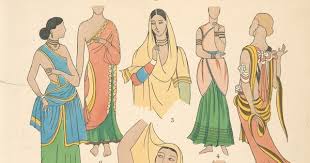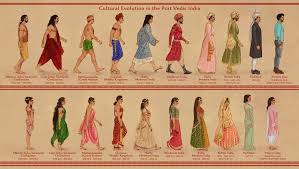Traditional Costumes and History of Clothing in India
Discussing the changes Indian Clothes have undergone, with specific instances.
09 Aug '25
4 min read

India is one of the most diverse nations in the world. We are home to around 1.42 billion people. Each one of our states has its own identity, its own culture and traditions, and its own attire. Each Indian state is reminiscent of many European nations. Uttar Pradesh, our most populous state, has the same population as Russia, and this proves the point. In the midst of this diversity, clothing is one of the most important factors that helps attest the diversity in India.
Our country is home to several forms of clothing. Each state has its own iconic clothing style, be it the saree and dhoti in Karnataka, the mundu in Kerala or the captivating salwar kameez and kurta pyjama of Punjab. Let us now reflect on the evolution that clothing has gone through passing years in India.
India contains of several types of traditional weaves, which have been passed on through generations, from time to time. These weaves reflect India’s vibrant cultural heritage and traditions to the outside world. Be it the very famed Kanjeevaram sarees of Tamil Nadu, the royal Banarasi silk sarees of Uttar Pradesh or the unique weaving styles of Northeast India, we have it all. We have no dearth of textiles in India and are blessed to experience it all in our India, for diversity of this measure is not seen anywhere else.
The evolution of clothing can be seen since millennia, from the humble traditional attires of the old times to the modern fusion clothing that is seen nowadays. Early Indian clothes consisted mainly of cotton. This was influenced by the Mughals, and the British later to change the traditional clothing, introducing new styles.

Evidences suggest the cultivation and use of cotton as far back as 2500BC, during the Indus Valley Civilization. Draped clothing like the dhoti for men and sari for women were common. As times passed, the use of silk and other fabrics became mainstream.
During the Mughal period, draping styles started to get several changes with respect to caste, religious and regional differences. New styles of styles and fabrics were introduces by them such as the Anarkali. Indian textiles such as cotton, muslin, and silk were highly sought after in Europe and other places.
The British rule introduced Western styles like skirts and trousers in India, clothes that have redefined our attire, Clothes which were then worn by just the educated and upper classes has now become common to all. Post-independence, a renewed interest was seen to revive traditional textiles. The Indian film industry, Bollywood, has further played a crucial role in shaping modern Indian fashion trends.
Woven textiles are deeply intertwined in the identity of each culture, community and tradition. They act as a vision that reflects the diverse cultures of each community and state, and boasts regional identities. These textiles were carriers of stories, legends and traditions passed down from generations.
The patterns and colors shown in these clothes are symbols for the community and have significance in the tradition of the group. The handloom industry provides employment to a large number of people and the growth in this industry has empowered several families.
It is during special ceremonies and events that the crux of Indian clothing can be seen. This varies greatly, but in most places, vibrant clothes are worn by the women and men taking part with intricate embroidery and symbolic fabrics. Sarees and sherwanis are popular choices for festive and ceremonial wear, incorporating special work done on it.
All in all, clothing in India is far more than just fabric; it is the perfect amalgamation of fabric, royalty and an expression of culture and our past. From the intricate designs to the blend of foreign and Indian trends, Indian clothing reflects a dynamic evolution. It serves as a powerful mark of heritage, something that helps us identify ourselves with. Indian tradition and culture is something that is praised by even other countries. Let us work towards conserving this.
~Rachan R Rai
Grade X
Category:Fashion
Written by RACHAN R RAI
A humble student with a keen interest in writing.
0 Followers
0 Following
